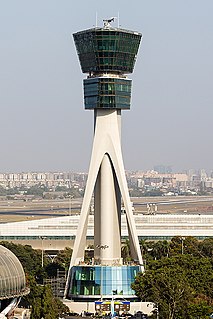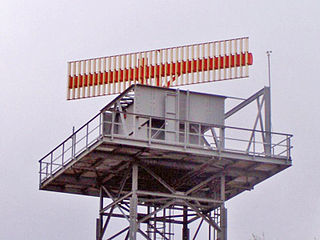
Air traffic control (ATC) is a service provided by ground-based air traffic controllers who direct aircraft on the ground and through controlled airspace, and can provide advisory services to aircraft in non-controlled airspace. The primary purpose of ATC worldwide is to prevent collisions, organize and expedite the flow of air traffic, and provide information and other support for pilots. In some countries, ATC plays a security or defensive role, or is operated by the military.

An intelligent transportation system (ITS) is an advanced application which aims to provide innovative services relating to different modes of transport and traffic management and enable users to be better informed and make safer, more coordinated, and 'smarter' use of transport networks.
Radar configurations and types is an article about listing the different uses of radars.

Secondary surveillance radar (SSR) is a radar system used in air traffic control (ATC), that unlike primary radar systems that measure the bearing and distance of targets using the detected reflections of radio signals, relies on targets equipped with a radar transponder, that reply to each interrogation signal by transmitting encoded data such as an identity code, the aircraft's altitude and further information depending on its chosen mode. SSR is based on the military identification friend or foe (IFF) technology originally developed during World War II, therefore the two systems are still compatible. Monopulse secondary surveillance radar (MSSR), Mode S, TCAS and ADS-B are similar modern methods of secondary surveillance.
The air traffic control radar beacon system (ATCRBS) is a system used in air traffic control (ATC) to enhance surveillance radar monitoring and separation of air traffic. It consists of a rotating ground antenna and transponders in aircraft. The ground antenna sweeps a narrow vertical beam of microwaves around the airspace. When the beam strikes an aircraft, the transponder transmits a return signal back giving information such as altitude and the Squawk Code, a four digit code assigned to each aircraft that enters a region. Information about this aircraft is then entered into the system and subsequently added to the controller's screen to display this information when queried. This information can include flight number designation and altitude of the aircraft. ATCRBS assists air traffic control (ATC) surveillance radars by acquiring information about the aircraft being monitored, and providing this information to the radar controllers. The controllers can use the information to identify radar returns from aircraft and to distinguish those returns from ground clutter.

The Erieye radar system is an Airborne Early Warning and Control System (AEW&C) developed by Saab Electronic Defence Systems of Sweden. It uses active electronically scanned array (AESA) technology. The Erieye is used on a variety of aircraft platforms, such as the Saab 340 and Embraer R-99. It has recently been implemented on the Bombardier Global 6000 aircraft as the Globaleye.

SELEX Sistemi Integrati S.p.A. was an aerospace, defence and security-related electronics manufacturing company headquartered in Rome, Italy and a wholly owned subsidiary of Finmeccanica. It designed and developed systems for homeland security; systems and radar sensors for air defence, battlefield management, naval warfare, coastal and maritime surveillance; air traffic control; and turn-key airport solutions. The company had around 4,500 employees. On 1 January 2013, it merged with its sister companies SELEX Galileo and SELEX Elsag to form Selex ES.

An airport surveillance radar (ASR) is a radar system used at airports to detect and display the presence and position of aircraft in the terminal area, the airspace around airports. It is the main air traffic control system for the airspace around airports. At large airports it typically controls traffic within a radius of 60 miles (96 km) of the airport below an elevation of 25,000 feet. The sophisticated systems at large airports consist of two different radar systems, the primary and secondary surveillance radar. The primary radar typically consists of a large rotating parabolic antenna dish that sweeps a vertical fan-shaped beam of microwaves around the airspace surrounding the airport. It detects the position and range of aircraft by microwaves reflected back to the antenna from the aircraft's surface. In the US the primary radar operates at a frequency of 2.7 - 2.9 GHz in the S band with a peak radiated power of 25 kW and an average power of 2.1 kW. The secondary surveillance radar consists of a second rotating antenna, often mounted on the primary antenna, which interrogates the transponders of aircraft, which transmits a radio signal back containing the aircraft's identification, barometric altitude, and an emergency status code, which is displayed on the radar screen next to the return from the primary radar. It operates at a frequency of 1.03 - 1.09 GHz in the L band with peak power of 160 - 1500 W.
ASTERIX is a standard for the exchange of air traffic services (ATS) information. It is developed and maintained by the European ATS organization Eurocontrol. ASTERIX not only stands for All-Purpose Structured Eurocontrol Surveillance Information Exchange but also represents a state-of-the-art surveillance data format which is nearly being adopted by the world users community as the universal standard in this domain today.
The Runway Status Lights (RWSL) system is a technology the Federal Aviation Administration (FAA) is deploying to make runways safer at busy airports. The system adds to the layers of protection already in place by providing visual alerts to pilots and drivers when runway traffic makes it unsafe to enter, cross, or begin takeoff. The lights enhance safety without affecting with normal and safe operations—an important consideration at airports that handle hundreds of operations an hour.

SASS-C is an acronym for "Surveillance Analysis Support System for ATC-Centre". SASS-C Service is part of Eurocontrol Surveillance Tools unit.

Automatic dependent surveillance–broadcast (ADS–B) is a surveillance technology in which an aircraft determines its position via satellite navigation and periodically broadcasts it, enabling it to be tracked. The information can be received by air traffic control ground stations as a replacement for secondary surveillance radar, as no interrogation signal is needed from the ground. It can also be received by other aircraft to provide situational awareness and allow self-separation. ADS–B is "automatic" in that it requires no pilot or external input. It is "dependent" in that it depends on data from the aircraft's navigation system.

Anchorage Air Route Traffic Control Center (PAZA/ZAN) is located just outside the main gate of Joint Base Elmendorf-Richardson at 700 North Boniface Parkway in Anchorage, Alaska, United States. The Anchorage ARTCC is one of 22 Air Route Traffic Control Centers in the United States.

ARTAS is a system designed by Eurocontrol to operationally support Aerial surveillance and Air traffic control by establishing an accurate Air Situation Picture of all traffic over a pre-defined geographical area and then distributing the relevant surveillance information to a community of user systems.

RMCDE is the name of a system designed to distribute the surveillance information to a community of user systems.

CIMACT is EUROCONTROL's Civil-Military Air Traffic Management Co-ordination Tool.
Remote and virtual tower (RVT) is a new concept where the air traffic service (ATS) at an airport is performed somewhere else than in the local control tower.

Communications-based train control (CBTC) is a railway signaling system that makes use of the telecommunications between the train and track equipment for the traffic management and infrastructure control. By means of the CBTC systems, the exact position of a train is known more accurately than with the traditional signaling systems. This results in a more efficient and safe way to manage the railway traffic. Metros are able to improve headways while maintaining or even improving safety.
Kongsberg Geospatial is a Situational Awareness and Geospatial Visualization software company located in Ottawa, Ontario, Canada. It was founded in 1992 as Gallium Visual Systems Inc. and purchased in 2006 by Norwegian Defence firm Kongsberg Gruppen. It currently operates as a subsidiary of Kongsberg Defence & Aerospace and in 2012, officially changed its name to Kongsberg Gallium Ltd. In 2016, the company changed its name again to Kongsberg Geospatial.

A Primary radar is a conventional radar sensor that illuminates a large portion of space with an electromagnetic wave and receives back the reflected waves from targets within that space. The term thus refers to a radar system used to detect and localize potentially non-cooperative targets. It is specific to the field of air traffic control where it is opposed to the secondary radar which receives additional information from the target's transponder.













